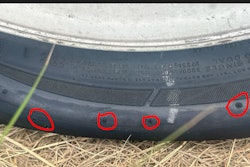This year’s update on average fleet operating costs from the American Transportation Research Institute reported a staggering increase in the average operating cost per mile for the second year in a row -- almost a half-dollar/mile, totaling up to a historically high $2.25 per mile. That’s an increase we’d expect to lead a stampede to the exits from trucking by a huge array of carriers, small and large.
Times are tough, sure, yet judging by the recent commentary of Werner’s CEO, it’s also sure many independents and small fleets are hanging in just fine. (The CEO expressed veritable shock at small fleets’ resilience given the harsh rates/high cost environment.)
Spot market rates for vans have been ticking along well below that $2.25/mile figure for quite some time now, reefers and flats most weeks not very far at all above it, leading the Werner CEO to wonder at how small fleets and independents could run at a loss for so long.
How could that be? Whether you're making a decision to accept a reduced profit expectation or to simply not pay yourself for as long as possible, making enough to get the old truck down the road, it's easy to rationalize actions in all sorts of ways.
Routine can set a trap, though. The longer difficult conditions persist, the more likely reduced expectations become the standard operating procedure. That’s a good way to slowly fail in business and find yourself among the legions of former owners driving company trucks.

What some miss about ‘capacity’: The big picture
Many owner-operators and fleets received a huge injection of capital through the various emergency-loan programs during the pandemic. I see these functioning as a safety net for some owners who, in another time, might have downsized or closed their business altogether.
Sitting on the sidelines and living off cash reserves in wait for the market to turn isn’t exactly a new, original game plan. Those with a more independent mindset, and with financial stability, did much the same through much harder times, such as the 2008 recession.
There’s a high probability older, veteran owner-operators may also have other sources of income, whether from personal savings, retirement accounts or a spouse with family benefits and a steady income. With their trucks paid off, working a semi-retired schedule while refusing to haul unprofitable loads, such owners have prepared well for this moment.
Yet while older owner-ops are increasingly leaned on by the younger generation -- via much freer-flowing information with today’s mentoring and online social media groups and other venues -- know that there are big risks to sitting too comfortably on the sidelines, for too long. If cherry-picking loads is your entire plan, you risk your own eventual invisibility, irrelevance to the brokers and customers who helped you grow and/or maintain your business in better times. As one agent told me years ago, “Selling the $4 a mile load is never a problem.”
They’ll certainly favor the owner-operator who has proven they’ll be there when needed.
Take the lead in negotiating, with a balanced approach. Make it a point to discuss how you the trucker and the broker/agent/customer might be able to help each other over the long run.
For others who’ve relied on those emergency loan programs, though, not all of the programs were forgivable loans that would never require repayment. Surely servicing accumulated debt is now impacting cash flow. Has the strategy only moved the failure timeline farther out?
That’s what folks like Werner’s CEO, and more recently the American Trucking Associations' Bob Costello, seem to think with seeming hopes for “capacity reduction” (that is, owners and fleets going out of business) to cut the supply side of the trucking market metrics. Most of you, I’d wager, don’t want to be a part of the capacity reduction statistic.
[Related: Direct freight: Delivering a modicum of consistency in a down market]
Think big, bold. Get creative
If you’re an owner operator with fewer years in business and are facing new difficult decisions, consider this example.
Two owner-operators I know, independent contractors leased on and both with a good history, became friends after meeting as entry-level drivers six years ago. Brad and Mike this summer decided to park one of their trucks and agree to a contract requiring they work together as a team operation. The original rate confirmation paid for just 10 days, then that offer turned into a 23-day contract with a final settlement of approximately $28,000, a per-mile rate greater than $3 overall for the revenue.
Canvassing my freight sources, I estimate loads requiring a team average a buck a mile higher than non-team loads. It’s not always extended miles or cramped time windows that necessitate the team -- security can play a role, too, particularly in the military’s arms, ammunition and explosives hauling program.
[Related: High-security munitions hauling: Bigger investment at start-up can mean rich rewards]
Yet don’t rush into this type of arrangement without assessing it fairly. Typically, whoever owns the truck in operation receives all the gross 1099 revenue. Talk to your tax preparers to assess the right way to pay the owner or driver you team up with. If you’re not paying yourself as a W2 employee, you may need to establish that to keep things fair after equipment costs -- then you'd also pay the team driver with a W2 paycheck. Recognize there may be worker’s comp and unemployment insurance requirements, too, that vary depending on the state where your business is set up.
If you’re struggling with extended downtime for repairs -- not uncommon these days -- teaming up with another owner could be a difference-maker, whether short- or long-term. Yet if you’re the running truck’s owner and you’ve never had an employee, don’t allow the vision of higher gross revenue outweigh the responsibilities and risk management that will follow.
Evaluate your potential profit before you jump, most definitely. But: I’d suggest running the numbers past someone you respect and trust as a business owner. In Brad and Mike’s case, after figuring out a way to divide the fixed and variable costs both owners were incurring between the two of them, Brad noted his personal net income per mile wasn’t a large amount greater than his average profits prior to teaming up. Considered another way, though -- net income per unit of time -- the temporary move was a success in a time of declining load availability. He and Mike both definitely made more money on the whole.
Use caution with other big moves
- Changing carriers. If you’re inclined to move from one leasing carrier to another in search of better opportunities, research the companies’ safety history via the FMCSA's Safer website and CSA Safety Measurement System, where you'll find a history of inspections, out of service violations and accidents. The very last thing a driver can afford is working with a company that does not place safety above speed, miles or hours worked.
- Operational shifts. Should you pull different equipment or operate within a different region of the country? If you are an independent owner-operator, do you shift to leasing on? Is there a company that has customers that better fit your skillset, or do you need to address adding specialized skills or equipment such as a hazmat endorsement, double and triple trailer endorsements, oversize certifications and the like. All of these options come with a huge set of costs in either time or money. Be sure the payoff is likely to be worth it before you jump.
Whatever your situation, never forget this tried-and-true approach to customer service: Provide the service the majority refuse to. In my past, I spent years hauling multiple-stop loads. They pay higher rates, and there's a reason for that -- often enough, they require plenty in the way of load and unload assistance. Truckers willing to do the work were relatively speaking fewer and farther between.
Owner-operator reticence for multi-stop loads seems to stem from early company-driving experiences with detention, and a belief that every stop will detain them for hours. While there is always a learning curve in recognizing loads that have lower risks for these issues, taking the lead with communication with each customer start to finish can set you up for a tremendously good return on investment.
My experience? The average delivery took about a half hour to 45 minutes. It bettered the odds that I'd more efficiently utilize my available time, too. These customers needed what I was hauling in almost all cases, to deliver to their final customer.













